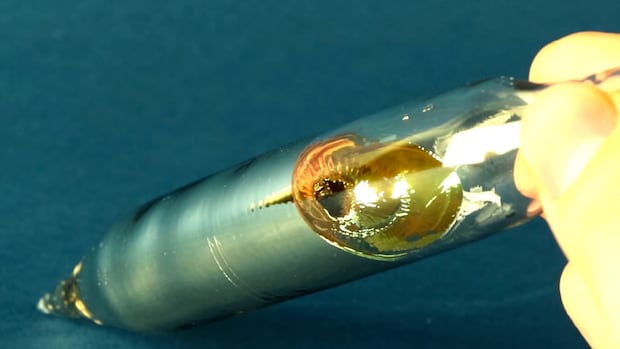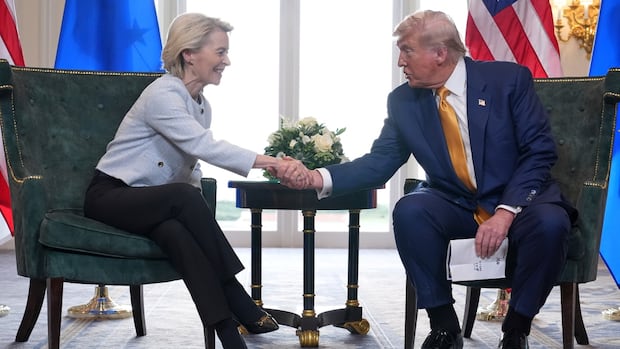WARNING: This article references sexual assault and may affect those who have experienced sexual violence or know someone affected by it.
The sexual assault trial of five former Canadian world junior hockey players in London, Ont., centres on the issue of consent — what it is and what it is not.
Michael McLeod, Dillon Dubé, Carter Hart, Cal Foote and Alex Formenton are each accused of sexually assaulting the then 20-year-old woman, known as E.M. under a standard publication ban, in June 2018. McLeod faces a second charge of being a party to the offence. All the accused have pleaded not guilty.
The Crown’s case focuses on the issue of consent, and includes two short videos of E.M. that were taken by McLeod and presented as evidence at the trial.
But CBC News spoke to experts who said that even after the #MeToo movement, the concept of consent isn’t always understood and some people are putting misplaced trust in videos mentioning it.
Kaitlynn Mendes is a sociology professor who holds the Canada Research Chair in inequality and equity at London’s Western University. She also researches technology-facilitated sexual violence.
“Consent is something that can only really happen in the moment.… Consent has to be ongoing. It’s something that can be withdrawn at any point,” said Mendes.
The video is not going to be determinative of whether there was consent at the time for the specific acts.– Lisa Kerr, Queen’s University, associate law professor
For example, she said, if someone has consented to having sex with one person and a second person enters the room, or they want to change acts, the participants need to get consent, in the moment, for everything that’s happening.
“That’s really the only case in which these videos, I think, could really stand up,” said Mendes, who also acknowledged recording a video in the moment of sexual activity isn’t so straightforward to do.
She said “consent videos” are meant to pre-empt accusations that a sexual encounter was not consensual by stating the level of physical activity you’re comfortable with before getting intimate.
They’re not new.
They became popular during the #MeToo movement, which focused on addressing sexual harassment and abuse, particularly in the workplace.
That movement gained international prominence in 2017 because of the allegations surrounding the Harvey Weinstein and Bill Cosby sexual assault cases.
What an accused, E.M. said in video evidence
At the trial for the five former world junior players, the Crown told court in its opening statement that E.M., 20 at the time, was at Jack’s bar with friends.
That same night, the Canadian world junior hockey team was at a gala celebrating their championship win months earlier, and then went to Jack’s bar.
Court has heard a few of the players, including McLeod, chatted up E.M., and she started dancing with him after she got separated from her friends.
The jury has viewed surveillance video from Jack’s that night that shows Dubé and McLeod dancing with E.M.
E.M., who began testifying on Friday and continues on Monday, also viewed some of the footage under questioning from the Crown.
Video shows McLeod and E.M. leaving the bar and going to the Delta hotel, where McLeod and his teammates were staying. E.M. and McLeod had consensual sex, said assistant Crown attorney Heather Donkers, adding that is not the problem — it’s what allegedly happened afterward. Soon after that, Donkers said, “the atmosphere in the room changed.”
Last week, the jury saw a short video in which a male voice asks E.M. if she’s “OK with all this stuff.” She responds, “Yeah, I’m OK.”
In a second video, recorded an hour later at 4:26 a.m., E.M. is shown with no clothing and holding a towel in front of her chest.
She tells the camera, “It was all consensual. Are you recording me? K, good. You are so paranoid. Holy. I enjoyed it. It was fine. I’m so sober — that’s why I can’t do this right now.”
Crown in hockey case argues videos not proof of consent
Donkers also said in her opening statement that the prosecution plans to argue the videos are not evidence that E.M. did, in fact, consent.
“The defendants took no steps to ensure there was affirmative consent when they touched her. Instead, they just did what they wanted,” Donkers said.
Mendes hasn’t seen the consent videos herself, but has questions about the context in which they were recorded. Who was in the room? Was there coercion or threats? Was the complainant sober and able to consent?
“We don’t know whether it was like, ‘Hey, you need to record this video before you’re allowed to leave.’ Are there other people standing around intimidating you? … Do they feel as though they’re being coerced into saying that, yes, this was consensual?”

Context is everything, says associate law prof
Lisa Kerr, an associate law professor at Queen’s University in Kingston, Ont., agrees that context is everything.
“For example, you might see on a video that the complainant is intoxicated and you might want to assess what you see on the video with the evidence at trial about their level of intoxication, right? Does it confirm it? Does it undercut it?” Kerr said.
“You might assess the demeanour of the complainant in the video. So, does the complainant appear to be calm? Are they confident? Are they comfortable? Or do they appear to sort of be distressed and ill at ease?”
Depending on what is recorded and how it’s interpreted, a consent video could benefit the prosecution or the defence.
“The video is not going to be determinative of whether there was consent at the time for the specific acts,” Kerr said. “The video may be helpful for assessing the credibility of witnesses, for sort of getting a sense of what was really going on here.”
Videos or app responses can give the illusion of navigating the ambiguities of consent, but if they are only recorded after a sexual encounter, Kerr said, they may be seen as an attempt to make up for a lack of consent at the time of the sexual activity.
If you’re in immediate danger or fear for your safety or that of others around you, please call 911. For support in your area, you can look for crisis lines and local services via the Ending Violence Association of Canada database.





